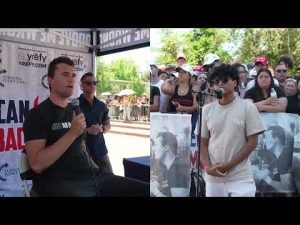The recent scenes in Los Angeles resemble a Hollywood disaster film—complete with a curfew, a fiery backdrop, and overly dramatic figures pretending everything is peaceful. It’s quite the spectacle. Unrest has erupted across the city, with protesters clashing with police, resulting in Governor Gavin Newsom and Mayor Karen Bass being dragged into the spotlight. The House Republicans have thrown their hats into the ring, launching an investigation into the situation, possibly sensing this is their golden opportunity to highlight a leadership breakdown.
Predictably, the far-left media has swooped in like an overprotective mother, insisting that these protests have been nothing short of a kumbaya session. They paint a rosy picture of people chanting, singing, and dancing, conveniently ignoring the parts where Molotov cocktails feature in the ensemble cast. Yes, ladies and gentlemen, Los Angeles is burning, and yet somehow, we are told the fire’s actually just a peaceful bonfire where marshmallows are being roasted.
The romance of peaceful protesting fades when the facts come into sharp focus. Across the nation, similar chaos is unfolding. In Seattle, police needed teargas to handle the fervent crowds, and could you believe it, rioters broke into an ICE facility in Portland. As the violence ramps up, leftist pundits continue to insist it’s all the fault of law enforcement. The idea that officers defending themselves against attacks with bricks, concrete, and a dash of Molotov still qualifies as peaceful is laughable.
This so-called peaceful movement reportedly supports migrants with criminal records as diverse as a lurid crime documentary. Curiously, many protest participants would rather hide behind masks and shields than let their identities be known. It seems easier to claim victimhood while simultaneously intimidating those tasked with maintaining order. Perhaps the protester’s wardrobe choice is an artistic expression that escaped the media’s notice?
In times of such political theater, one must wonder why some persist in believing these narratives. It’s intriguing to think that, for some, these demonstrations are a means to fill a void once occupied by faith or family. When their political “deity” doesn’t claim victory, their response is to protest, facing off against those who protect and serve. Yet, many of us find fulfillment in simpler things—faith, family, and weekends spent at home, not on the streets. But, who are we to judge when there are apparently battles of biblical proportion happening over there with the brick throwers and their sympathizers.







